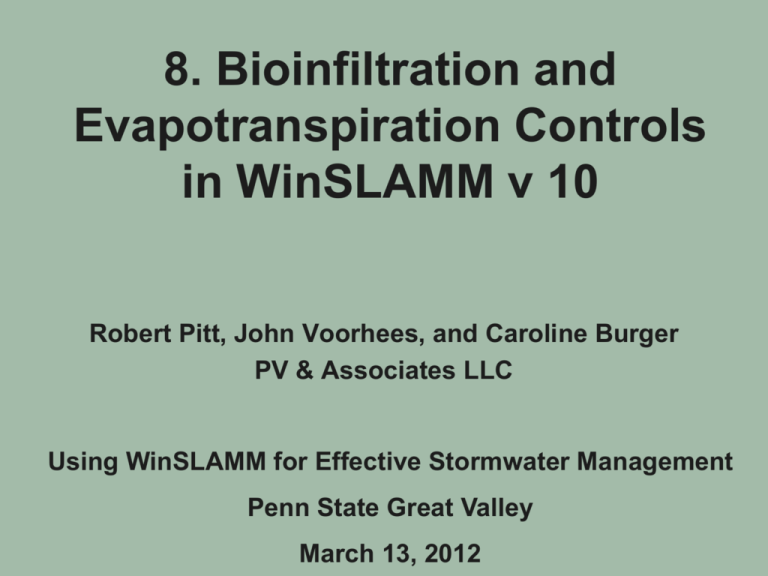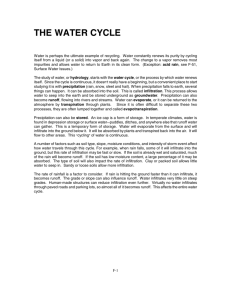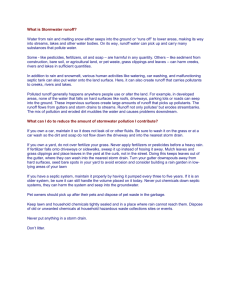WinSLAMM v 8.7 Model Features
advertisement

8. Bioinfiltration and Evapotranspiration Controls in WinSLAMM v 10 Robert Pitt, John Voorhees, and Caroline Burger PV & Associates LLC Using WinSLAMM for Effective Stormwater Management Penn State Great Valley March 13, 2012 Stormwater Constituents that may Adversely Affect Infiltration Device Life and Performance Sediment (suspended solids) will clog device Major cations (K+, Mg+2, Na+, Ca+2, plus various heavy metals in high abundance, such as Al and Fe) will consume soil CEC (cation exchange capacity) in competition with stormwater pollutants. An excess of sodium, in relation to calcium and magnesium (such as in snowmelt), can increase the soil’s SAR (sodium adsorption ratio), which decreases the soil’s infiltration rate and hydraulic conductivity. Ground Water Mounding “Rules of Thumb” Mounding reduces infiltration rate to saturated permeability of soil, often 2 to 3 orders of magnitude lower than infiltration rate. Long narrow system (i.e. trenches) don't mound as much as broad, square/round systems Modeling Notes Biofilter routing is performed using the Modified Puls Storage – Indication Method. Time increments are established by the model, start at 6 minutes Yield reductions due to runoff volume reduction through infiltration and filtering through engineered soil Control Practice Overview • Inflow rate – Low • All runoff flows through engineered soil • Native soil restricts below ground discharge • Water level below ground rises Control Practice Overview • Inflow rate – Moderate • All runoff flows through engineered soil • Native soil restricts below ground discharge • Water level below ground rises • Water discharges through underdrain Control Practice Overview • Inflow rate – High • Some runoff flows through engineered soil • Native soil restricts below ground discharge • Water level above ground rises • Water level below ground rises • Water discharges through underdrain Control Practice Overview • Inflow rate – High • Some runoff flows through engineered soil • Native soil restricts below ground discharge • Water level above ground rises • Water level below ground rises • Water discharges through underdrain and above ground Control Practice Overview • Inflow rate – Moderate • Some runoff flows through engineered soil • Native soil restricts below ground discharge • Water level above ground falls • Water level below ground falls • Water discharges through underdrain Control Practice Overview • Inflow rate – Moderate • All runoff flows through engineered soil • Native soil restricts below ground discharge • Water level above ground zeros out • Water level below ground falls • Water discharges through underdrain Control Practice Overview • Inflow rate – Zero • No runoff • Native soil restricts below ground discharge • Water level below ground falls • Water discharges through underdrain, eventually only through native soil Underdrain Effects on Water Balance 0.75 inch rain with complex inflow hydrograph from 1 acre of pavement. 2.2% of paved area is biofilter surface, with natural loam soil (0.5 in/hr infilt. rate) and 2 ft. of modified fill soil for water treatment and to protect groundwater. Conventional (3” perforated pipe) Underdrain 33% runoff volume reduction 85% part. solids reduction 7% peak flow rate reduction No Underdrain 78% runoff volume reduction 77% part. solids reduction 31% peak flow rate reduction 76% runoff volume reduction for complete 1999 LAX rain year 74% part. solids reduction for complete 1999 LAX rain year Restricted Underdrain 49% runoff volume reduction 91% part solids reduction 80% peak flow rate reduction Biofilter Geometry Biofilter Datum is always zero ft. Biofilter Data Entry Form Biofilter Geometry Outflow Structure Information Biofilter Data Entry Form Biofilter Data Entry Form Biofilter Data Entry Form Additional Output Biofilter Water Balance Biofilter Water Balance Performance Summary, by Event BioF Event Event Event Source Time Maximum Minimum Inflow Hydr Event Infil Evap Area Rain Rain (Julian BioF BioF Volume Outflow Outflow Outflow Number Number Depth (in) Date) Stage (ft) Stage (ft) (ac-ft) (ac-ft) (ac-ft) (ac-ft) 7 1 0.01 0 0.12 0 0 0 0 7 2 0.05 31 0.57 0 0.007 0 0.001 7 3 0.1 59 0.71 0 0.015 0 0.002 7 4 0.25 90 1.2 0 0.042 0 0.002 7 5 0.5 120 2.03 0 0.084 0 0.002 7 6 0.75 151 2.46 0 0.125 0 0.002 7 7 1 181 2.5 0 0.165 0.007 0.002 7 8 1.5 212 2.52 0 0.249 0.034 0.003 7 9 2 243 2.52 0 0.335 0.066 0.003 7 10 2.5 273 2.53 0 0.416 0.087 0.003 7 11 3 304 2.52 0 0.497 0.097 0.004 7 12 4 334 2.53 0 0.661 0.149 0.004 Event Cistern Outflow (ac-ft) 0 0 0 0 0 0 0 0 0 0 0 0 Event Orifice Outflow (ac-ft) 0 0 0 0 0 0 0 0 0 0 0 0 0 0.006 0.013 0.041 0.082 0.122 0.156 0.213 0.266 0.326 0.396 0.507 Event Total Outflow (ac-ft) 0 0.007 0.015 0.042 0.084 0.125 0.165 0.249 0.335 0.416 0.497 0.661 Event Flow Balance (ac-ft) Volume Solids Reduction Reduction Fraction Fraction 0 1 0 0 0.183 0 0 0.095 0 0 0.043 0 0 0.024 0 0 0.018 0 0 0.014 0 0 0.01 0 0 0.008 0 0 0.008 0 0 0.008 0 0 0.007 0 Other Output Options Time step detail Irreducible concentration Particulate reduction Stage outflow Stochastic seepage rates Stochastic seepage rates Evapotranspiration Kansas City’s CSO Challenge Combined sewer area: 58 mi2 Fully developed Rainfall: 37 in./yr 36 sewer overflows/yr by rain > 0.6 in; reduce frequency by 65%. 6.4 billion gal overflow/yr, reduce to 1.4 billion gal/yr Aging wastewater infrastructure Sewer backups Poor receiving-water quality Kansas City Middle Blue River Outfalls 20 744 acres Distributed storage with “green infrastructure” vs. storage tanks Need 3 Mgal storage Goal: < 6 CSOs/yr Kansas City’s Original Middle Blue River Plan with CSO Storage Tanks 1/26/2009 Adjacent Test and Control Watersheds Kansas City 1972 to 1999 Rain Series Water Harvesting Potential of Roof Runoff Supplemental Irrigation Needs Evapotranspiration per Month (typical turfgrass) per Month (typical turfgass) 1.50 1.00 0.50 0.00 Jan Feb Mar Apr May Jun Jul Aug Sep Oct Nov Dec Monthly Rainfall Rainfall (inches/week) 2 1.5 1 0.5 0 Jan Feb Mar Apr May Jun Jul Aug Sep Oct Nov Dec Irrigation needs (inches/week) ET (inches/week) 2.00 2.00 1.50 1.00 0.50 0.00 Jan Feb Mar Apr May Jun Jul Aug Sep Oct Nov Dec Irrigation needs for the landscaped areas surrounding the homes were calculated by subtracting long-term monthly rainfall from the regional evapotranspiration demands for turf grass. Percent reduction in annual roof runoff Reductions in Annual Flow Quantity from Directly Connected Roofs with the use of Rain Gardens (Kansas City CSO Study Area) 100 90 80 70 60 50 40 30 20 10 0 0.1 1 10 Percent of roof area as rain garden 100 Household water use (gallons/day/house) from rain barrels or water tanks for outside irrigation to meet ET requirements: January February March April 42 172 55 104 July August September October 357 408 140 0 May June 78 177 November December 0 0 Percentage reduction in annual roof runoff Reductions in Annual Flow Quantity from Directly Connected Roofs with the use of Rain Barrels and Water Tanks (Kansas City CSO Study Area) 100 90 80 70 60 50 40 30 20 10 0 0.001 0.01 0.1 Rain barrel/tank storage (ft3 per ft2 of roof area) 1 0.12 ft of storage is needed for use of 75% of the total annual runoff from these roofs for irrigation. With 945 ft2 roofs, the total storage is therefore 113 ft3, which would require 25 typical rain barrels, way too many! However, a relatively small water tank (5 ft D and 6 ft H) can also be used. rain barrel storage per house (ft3) tank height tank height # of 35 gallon size required size required if rain barrels if 5 ft D (ft) 10 ft D (ft) 0 0 0 0 4.7 1 0.24 0.060 9.4 19 47 2 4 10 0.45 0.96 2.4 0.12 0.24 0.60 118 470 25 100 6.0 24 1.5 6.0 Examples from plans prepared by URS for project streets. Construction will be completed in spring and summer of 2012. Annual Runoff Reductions from Paved Areas or Roofs for Different Sized Rain Gardens for Various Soils Reduction in Annual Impervious Area Runoff (%) 100 10 clay (0.02 in/hr) silt loam (0.3 in/hr) sandy loam (1 in/hr) 1 0.1 1 10 Rain Garden Size (% of drainage area) 100 Clogging Potential for Different Sized Rain Gardens Receiving Roof Runoff Years to Clogging 10000 1000 100 years to 10 kg/m2 years to 25 kg/m2 10 1 0.1 1 10 100 Rain Garden Size (% of roof area) Clogging not likely a problem with rain gardens from roofs Clogging Potential for Different Sized Rain Gardens Receiving Paved Parking Area Runoff Years to Clogging 1000 100 10 years to 10 kg/m2 years to 25 kg/m2 1 0.1 1 10 100 Rain Garden Size (% of paved parking area) Rain gardens should be at least 10% of the paved drainage area, or receive significant pre-treatment (such as with long grass filters or swales, or media filters) to prevent premature The most comprehensive fullscale study comparing advanced stormwater controls available. Available at: http://pubs.usgs.gov/ sir/2008/5008/pdf/sir_ 2008-5008.pdf Parallel study areas, comparing test with control site Reductions in Runoff Volume for Cedar Hills (calculated using WinSLAMM and verified by site monitoring) Type of Control Runoff Volume, inches 1.3 Expected Change (being monitored) No Controls 6.7 515% increase Swales + Pond/wetland + Infiltration Basin 1.5 78% decrease, compared to no controls 15% increase over pre-development Pre-development Monitored Performance of Controls at Cross Plains Conservation Design Development Construction Phase Rainfall (inches) Volume Leaving Basin (inches) Percent of Volume Retained (%) 1999 Pre-construction 33.3 0.46 99% 2000 Active construction 33.9 4.27 87% 2001 Active construction 38.3 3.68 90% 2002 Active construction (site is approximately 75% built-out) 29.4 0.96 97% Water Year WI DNR and USGS data








